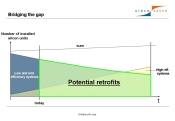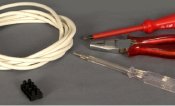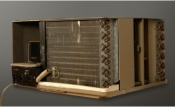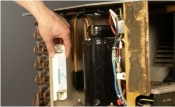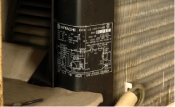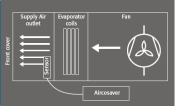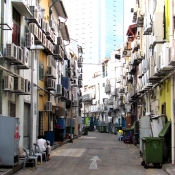


AIRCOSAVER, the original aircon energy saverImproving energy efficiency is the best short-term answer to today's energy problems. Our aircon energy saver can help!Until cleaner and sustainable sources of energy become available on a large scale, improving the energy efficiency of today's systems is important to reduce CO2 emissions and overall energy consumption. And the good thing is: It also saves you money! The AIRCOSAVERô is an aircon energy saver which...

About the AircosaverôAir conditioning has a huge potential for efficiency improvementsAir conditioning is one of the largest energy consumers in the residential and industrial sector. Thousands of air conditioners put high demands on our electricity networks. On a smaller scale, air conditioning probably accounts for a significant part of your energy bill. Many existing air conditioners use old and quite inefficient technology. Although improved technology has become available in more expensive systems (e.g. inverter technology), the payback time of these systems is still very long and most of this technology is not suitable as an easy and economical aftermarket fit to existing systems. In the light of today's energy problems, global warming and since older and not so advanced aircon systems will be in use for many more
years in large numbers, we have analysed various existing energy saving techniques for air conditioning systems
and reviewed plenty of earlier research. The conclusion was that detecting the system's efficiency and switching the
compressor accordingly is probably the only effective, pragmatic and economical measure to achieve a better energy efficiency.
There is no "free lunch" with any retrofit, but these savings come at no or only very small decreases in cooling comfort. Upgrade your unitInstead of investing a lot of money into an expensive new system, there is an easy and affordable way to improve the energy efficiency of your existing unit: Read why the Aircosaverô can save energy and money >> About the air conditioning energy saver - Shortcomings of typical AC systemsA typical cooling cycleWhen switched on, typical air conditioning systems operate continuously until the room thermostat senses the desired temperature and turns the system off. As the room warms up, the thermostat switches the air conditioner back on and the cycle repeats. Most air conditioning systems are oversized for the majority of operating conditionsAir conditioning systems are usually dimensioned to cope with the extreme cooling demands of the few hottest days of the year (plus a safety margin). However, in most operational conditions, this maximum output is not required and the system is oversized. So running the system continuously until the room thermostat switches it off means that the system operates with excess capacity most of the time. A typical cooling cycle with excess capacity looks like this:
Running the compressor beyond this stage does not increase the cooling effect any more. It's just a waste of energy! Read how the Aircosaverô compensates these shortcomings >> About the Aircosaverô - How does it work?The aircon energy saver compensates the shortcomings of typical AC units and adds intelligence to your AC systemThe Aircosaver's sensor-driven software algorithms are designed to detect thermodynamic saturation and to optimize the compressor accordingly. When overcapacity is detected, the Aircosaverô switches the compressor off and avoids inefficient overcooling. Your unit switches into "saver mode". The fan keeps running and your system makes maximum use of the stored cooling energy in the heat exchanger. Once the stored energy is used up, the compressor can work efficiently again and is switched back on. The set room temperature is reached without the inefficient parts of the cooling cycle. This results in significant energy savings without compromising cooling comfort. Since the correct point to switch the compressor varies from unit to unit and changes with different weather conditions, the Aircosaverô is constantly monitoring the cooling status of your aircon unit and adapting its settings to ensure efficient operation of your air conditioning system at all times. Protecting your unit against short cyclingCycling the compressor too frequently in too short time intervals may harm the compressor and must be avoided. For this reason, the Aircosaverô features a built-in anti short cycling protection. Besides the continuous anti short cycling protection, the Aircosaverô also adds a delay upon power-on to your unit. This valuable feature protects your aircon unit against damages from short power outages like they are common in many developing countries. See how the Aircosaverô is installed >> About the Aircosaverô - features & benefits of the second Aircosaver generationEasier to installHigher savings due to improved software algorithmBetter protection for your aircon unitFurther product featuresHow to get your Aircosaverô >> The Aircosaverô Upgrading PhilosophyYour satisfaction is our top priority. We would like to give you as much information as possible to enable you to make an informed choice. We would like to detail why installing an Aircosaverô makes sense and what can and can not be achieved. Air conditioning is a major consumer of electrical powerIn many of the warmer countries around the world air conditioning is one of the largest energy consumers in the residential and industrial sector. On a small scale air conditioning accounts for a large part of home and business owners' energy bills. Millions of simple air conditioning units waste unbelievable amounts of energy every day. Not only is the absolute power demand for air conditioning very high, but air conditioning also contributes to extreme peak energy demand on the hottest days of the year which the energy infrastructure has to cope with. Yesterday's aircon technology will be around for many yearsOur advice to any owner of a low efficiency window unit or single split system is "Replace your entire old system today and buy a new ultra-high efficiency system. Make sure it is dimensioned properly, that it is HCFC free and that it uses the most advanced compressor and control technology!" No matter how desirable this kind of change is, reality is different! There are millions of older systems in use. In 2001 the Intergovernmental Panel on Climate Change (IPCC) estimated that woldwide a total of over 289 million window/wall mounted units and unducted single split systems were in use. In addition, an increasing number of these types of systems is installed every year. In 2001 only for the mentioned types of systems this number was estimated to be almost 38 million, many of them still being low and mid efficiency units. The most efficient new air conditioning systems are simply too expensive for many applications and payback time is still too long. Besides, many countries still have not adopted high-efficiency standards for new systems. So these simple units will be operating on a large scale for many years to come. They will not just go away. Nor will they be replaced quickly. Average equipment lifetime is typically twelve to fifteen years and in many cases much longer. However, usually these units are not considered for retrofits. Controller manufacturers usually prefer to focus on very large system where even small improvements can be sold for high prices. Solution: Bridging the gap with a cost effective retrofit
Savings mechanism of the AircosaverôAs engineers we do not believe in miracles and we are sure you don't, either. When we began designing a controller specifically for retrofit purposes, we conducted a lot of research and experimented with various principles (more details here). We also came across all sorts of "unique" devices and "black boxes" that claim phantastic energy savings. Over time we became deeply persuaded that the most effective and practical method to create significant savings with the smallest tradeoffs in cooling comfort is to determine the system's current thermodynamic efficiency and switch the compressor off, when it is evidently inefficient. This is logical since the compressor typically acccounts for 80% of the system's energy consumption. This, in combination with protecting the compressor against potentially harmful short cycling led to the Aircosaverô. We think that out of all retrofit solutions and out of all proposed cycling methods this is the most effective with the smallest costs in cooling comfort. Limitations of any retrofitNo retrofit will do miracles. With a given system there is always a limit to the possible improvements in energy efficiency. A number of factors are fixed such as the type and efficiency of the refrigerant in the system. Other factors can be optimized such as the runtime of the compressor. A retrofit will not remedy major planning mistakes or technical faults in your system. What the Aircosaverô can achieveAn Aircosaverô will improve the overall energy efficiency of your system. Typical energy savings are up to 30%. Generally these savings come at very small, hardly noticeable decreases in cooling comfort. It uses the the circuitry and switches available in (and designed for) your system and does not require replacement of electronic components. The Aircosaverô just adds one control dimension (thermodynamic saturation) to your system and compensates your system's deficits. Overall assessmentWeighing the potential small tradeoffs against the significant energy savings, we think that the Aircosaverô is the optimum measure for achieving a significant improvement in energy efficiency. Furthermore, these savings come at an affordable and reasonable cost which will result in a short payback period. How to get your Aircosaverô >>Installation overview
Installation is complete. Your AC system is ready to save energy!Read about the improvements of the new Aircosaverô generation >> LinksAir ConditioningEnergy & EnvironmentPartners & FriendsHave a good laugh :-) |
© photos (from top): |



